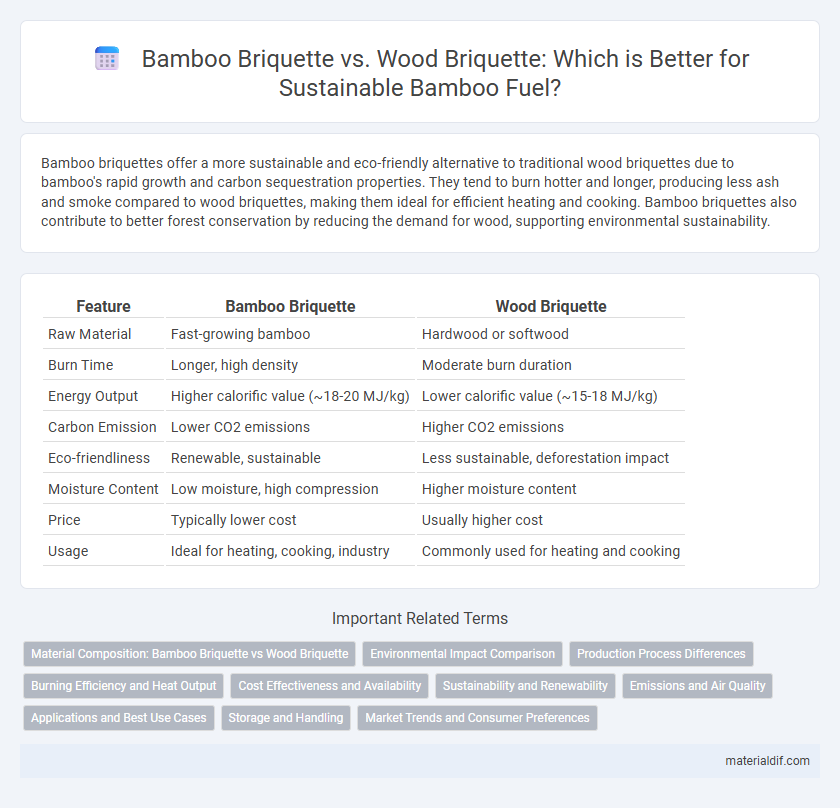Bamboo briquettes offer a more sustainable and eco-friendly alternative to traditional wood briquettes due to bamboo's rapid growth and carbon sequestration properties. They tend to burn hotter and longer, producing less ash and smoke compared to wood briquettes, making them ideal for efficient heating and cooking. Bamboo briquettes also contribute to better forest conservation by reducing the demand for wood, supporting environmental sustainability.
Table of Comparison
| Feature | Bamboo Briquette | Wood Briquette |
|---|---|---|
| Raw Material | Fast-growing bamboo | Hardwood or softwood |
| Burn Time | Longer, high density | Moderate burn duration |
| Energy Output | Higher calorific value (~18-20 MJ/kg) | Lower calorific value (~15-18 MJ/kg) |
| Carbon Emission | Lower CO2 emissions | Higher CO2 emissions |
| Eco-friendliness | Renewable, sustainable | Less sustainable, deforestation impact |
| Moisture Content | Low moisture, high compression | Higher moisture content |
| Price | Typically lower cost | Usually higher cost |
| Usage | Ideal for heating, cooking, industry | Commonly used for heating and cooking |
Material Composition: Bamboo Briquette vs Wood Briquette
Bamboo briquettes consist primarily of compressed bamboo fibers, which offer higher silica content and faster renewability compared to wood briquettes made from hardwood or softwood sawdust. The denser, fibrous structure of bamboo results in briquettes with lower moisture content and higher energy output per unit. Wood briquettes often contain more lignin and resin, influencing combustion characteristics and ash production differently than bamboo-based materials.
Environmental Impact Comparison
Bamboo briquettes offer a more sustainable alternative to wood briquettes due to bamboo's rapid growth rate, which can be harvested every 3-5 years compared to decades for traditional hardwoods. Bamboo cultivation enhances carbon sequestration and reduces soil erosion, resulting in a lower carbon footprint during production. In contrast, wood briquettes often rely on slower-growing trees, contributing to deforestation and higher greenhouse gas emissions.
Production Process Differences
Bamboo briquette production involves harvesting fast-growing bamboo, drying it, and compressing the fibers with minimal additives, resulting in a sustainable and eco-friendly fuel source. Wood briquettes require the processing of slow-growing hardwoods or softwoods, involving chipping, drying, and compressing sawdust or wood residues, which often contain higher lignin content for natural binding. The shorter growth cycle of bamboo allows for more frequent harvesting, reducing production time and resource consumption compared to traditional wood briquettes.
Burning Efficiency and Heat Output
Bamboo briquettes exhibit higher burning efficiency and greater heat output compared to wood briquettes, due to their denser composition and lower moisture content. Studies show bamboo briquettes can reach temperatures up to 850degC, releasing more energy per kilogram, which enhances fuel economy. The faster ignition and longer burn time of bamboo briquettes make them an eco-friendly and cost-effective alternative for heating applications.
Cost Effectiveness and Availability
Bamboo briquettes offer superior cost effectiveness compared to wood briquettes due to faster growth rates and higher yield per hectare, resulting in lower raw material costs. Bamboo's rapid renewability ensures greater availability, making it a more sustainable and consistent resource for briquette production. In contrast, wood briquettes often face supply limitations and higher prices linked to longer tree maturation periods and deforestation concerns.
Sustainability and Renewability
Bamboo briquettes offer superior sustainability compared to wood briquettes due to bamboo's rapid growth cycle, which can reach maturity within 3-5 years, significantly faster than most hardwood trees that take decades. Bamboo's high carbon sequestration rate further enhances its renewability, making it an eco-friendly alternative for biomass fuel. Unlike traditional wood briquettes, bamboo briquettes reduce deforestation pressure and promote sustainable resource management in biomass energy production.
Emissions and Air Quality
Bamboo briquettes produce significantly lower carbon monoxide and particulate matter emissions compared to wood briquettes, resulting in improved indoor and outdoor air quality. The combustion of bamboo briquettes releases fewer volatile organic compounds (VOCs) and nitrogen oxides (NOx), which are major contributors to air pollution and respiratory issues. Studies show that using bamboo briquettes can reduce harmful emissions by up to 30%, promoting cleaner combustion and healthier environments.
Applications and Best Use Cases
Bamboo briquettes offer superior eco-friendly fuel options for residential heating, cooking, and industrial boilers compared to wood briquettes, due to their higher density and faster combustion rate. They are ideal for applications requiring quick ignition and sustained heat, such as commercial cooking and power generation, while wood briquettes excel in slow-burning scenarios like home fireplaces and barbecue grilling. Bamboo's rapid renewability and low ash content make it the best choice for sustainable energy projects and eco-conscious consumers.
Storage and Handling
Bamboo briquettes offer superior storage advantages over wood briquettes due to their lower moisture content and higher density, reducing the risk of mold and enhancing shelf life. Their compact size and uniform shape facilitate easier stacking and transportation, minimizing space requirements and handling effort. Unlike wood briquettes, bamboo briquettes are less prone to crumbling during transport, ensuring cleaner storage environments and safer handling conditions.
Market Trends and Consumer Preferences
Bamboo briquettes are gaining market share due to their faster growth cycle and sustainability compared to traditional wood briquettes, appealing to environmentally-conscious consumers. Market trends indicate a rising demand for bamboo briquettes in regions with strict deforestation regulations, reflecting a shift towards renewable fuel sources. Consumer preferences favor bamboo briquettes for their higher calorific value, lower ash content, and reduced smoke emissions, enhancing indoor air quality and fuel efficiency.
bamboo briquette vs wood briquette Infographic

 materialdif.com
materialdif.com